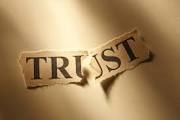 Just imagine a workplace that relies on fraud, deceit and regular scams as a way of doing business. Its niche is carved out of false promises and open lies. Thankfully, most organizations like this only enjoy a very brief existence. Contrast the very corrupt organization with one holding a spotless record and unblemished past, and it becomes logical that many organizations fit somewhere between these two extremes. Tenuous balances of trust and stress underlie all business activity.
Just imagine a workplace that relies on fraud, deceit and regular scams as a way of doing business. Its niche is carved out of false promises and open lies. Thankfully, most organizations like this only enjoy a very brief existence. Contrast the very corrupt organization with one holding a spotless record and unblemished past, and it becomes logical that many organizations fit somewhere between these two extremes. Tenuous balances of trust and stress underlie all business activity.
Lack of trust will undermine any leadership strategy. If employees don’t feel trusted, they will guard their words and be reluctant to offer input. The job becomes All Work & No Say as soon as a lack of trust steals the inspiration away.
Symphony of Trust
A leadership skill many don't talk about is trust. How much do you trust your staff and why does it matter? Trust affects the bottom line: the way you treat your employees is the way they will treat clients. If it’s acceptable that an organization or leader doesn’t have to keep promises, then you can almost guarantee employees won’t be keeping promises to clients either.
“People do business with people they trust.” You’ve heard this before. A client’s trust in an organization starts with a leaders trust in its employees. As Leadership Expert and Motivational Speaker, Lance Secretan quips in Reclaiming Higher Ground, “Our society is suffering from truth decay.” He holds that, especially in teams, telling the truth is essential to good business. “If the members of a symphony lie to each other, they will play awful music,” he maintains. So it goes in any leadership team environment. Another compelling advantage for telling the truth is that it’s efficient. Over a third of an organization’s budget may be devoted to administrative functions such as controls, reports and procedures. Many controls exist because leadership doesn’t trust employees. What if we could nix some of these controls and have our leadership strategy to be trust each other to do our best? It would be much less expensive and much more efficient.
EXPLODING THE TRUST MYTH:"WE TRUST EACH OTHER"
Many organizations think that trust isn’t a concern. On the surface everything is fine, but on closer inspection one might discover that employees are seeking to satisfy only their basic immediate needs. Their inspiration and passion is lost in the details of the job. Over time, working in such an atmosphere precipitates lethargy for some, and for others, illness. Workplace wellness declines.
Advantages to an Open Trusting Workplace
- Employees are more willing to contribute their ideas.
- Saves resources (time and money).
- Fuels creativity, innovation and productivity.
- Encourages controlled risk taking.
- “Forbidden topics” create fear and take up a lot of personal energy that can be freed up and used for more productive work.
- Employees will be more eager to get involved knowing they are trusted. More involved = more motivated.
- Promotes richer relationships among staff.
Keynote Speaker Tips on How to Build Trust Through Information
As the Keynote Speaker for the Annual Transportation Conference, building trust was my main theme. From my audience research, this was a very critical.
In the keynote presentation, I said, "Imagine your first day on the job in a new organization. As you walk in the door, you notice rooms that are off-limits to everyone but the leadership. Day after day, you see that information is carefully guarded and watched. Meetings occur behind closed doors. As leaders walk around, you sense they know something you don’t. Does this sound like a fun and productive work environment?"
What’s the big deal? Why do we guard information so carefully? Showing a distinct lack of trust, what kind of leadership quality is that?
Company information is often seen as intellectual property for both the organization and for individuals who develop it. People put effort into creating information and ideas and start to take ownership of them. In doing so, it becomes territorial and guarded. Pretty soon, a wedge develops between those who have access to information and those who don’t. Individuals start to see they are excluded and feel disconnected from the whole vision of the organization. This diminishes trust and it causes people to guard their ideas and limit their input. As a keynote speaker, this is a common theme in many conferences.
Information bonds people to one another. It's an important part of the positive growth and sense of community within an organization. Cutting people off from access to information is unhealthy for progress. Leadership needs to find ways to make information accessible to everyone.
If meetings must occur behind closed doors, make sure others in the department are included. Encourage people to bring their information and ideas to the meeting. Create an after meeting follow-up bulletin that discusses what was said. Much of the important information you get will not be written. Instead, it comes in chance conversations, briefly mentioned in meetings, in the elevator or in the lunchroom. Verify important information and make a point of distributing it to employees.
Explain the reason for any leadership and change initiative, and how it will serve management, employees, customers, suppliers, etc. Keep employees well informed of what is going on, why it is happening, and how it affects their job and the leadership in the organization as a whole. Ask for suggestions and involve everyone as much as possible. Remember that employees are the resource that makes things happen; therefore, it is essential to get their buy-in.
Managing information may be tricky. While you want to keep people informed, you don’t want to overwhelm them with information they don’t need to know. An important keynote- remember presentation is the key.
A COMMUNICATION SYSTEM TO MAKE INFORMATION ACCESSIBLE AND BUILD TRUST
Decide on the type of information and how you should disseminate it:
1. Organizational philosophy is anything related to the long-term mission, vision or direction of the organization. This information is very relevant to all employees because it is the “glue” that holds diverse departments of an organization together in a shared purpose. However, it does not need to be presented at year-end when everyone is swamped with work. Save this information and present the bigger picture on a monthly basis to help staff maintain focus. You may also have a newsletter devoted to initiatives that support the organization’s purpose and vision.
2. Operations and procedures. If information relates directly to an employee’s day-to-day job, the sooner she knows about it the better. If information is important, you need a consistent system to disseminate it efficiently and effectively. That may be through staff meetings, individual coaching, bulletins or announcements. If the information is critical to the job, then a feedback or follow-up procedure will be necessary to ensure it is being incorporated. Develop a channel strictly for sharing critical information so that employees pay attention.
3. Incomplete information. Very often managers will hear word of potentially “nasty” things like mergers or layoffs that would affect staff adversely. Some of this information may be sensitive and still tentative. If you don’t have full information, you run the risk of putting people on the defensive. Since they don’t have all the pieces of the complete puzzle they may rush to false conclusions which puts you in an awkward situation. Information should be communicated in a uniform and consistent way to prevent a “leak” of partial facts, which will be subject to rumor and false conclusions. Beware of selectively putting some people in the know and not others.
If you consistently organize and disseminate information through established means, then it is more readily understood. Employees will get used to getting updates about directives once a month in a meeting and will develop ways to utilize the information.
Make Mistakes More Often
Encourage employees to risk making mistakes and create an atmosphere that encourages them to be open when errors occur. When people make mistakes they usually feel guilty and try to cover up—an unfortunate reaction that inhibits the learning process. Mistakes are a part of growth. Permit them to be shared so that others may also learn from the example. This will foster an environment of openness that encourages creativity and autonomy. Celebrate solving mistakes as a victory.
Final Say
Who gets the final say? Your employees do. Build trust in your office by involving employees and including their input. Engage them as part of the problem and they will surprise you with honest solutions. The foundation of trust in any organization is built on a concrete base of openness and input from others.


